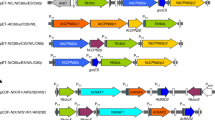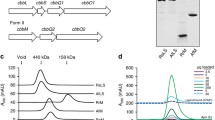Abstract
Ribulose-1,5-bisphosphate carboxylase/oxygenase (Rubisco) is prone to inactivation from non-productive binding of sugar-phosphates. Reactivation of Rubisco requires conformational remodeling by a specific chaperone, Rubisco activase. Rubisco activase from tobacco and other plants in the family Solanaceae is an inefficient activator of Rubisco from non-Solanaceae plants and from the green alga Chlamydomonas reinhardtii. To determine if the Rubisco small subunit plays a role in the interaction with Rubisco activase, a hybrid Rubisco (SSNT) composed of tobacco small subunits and Chlamydomonas large subunits was constructed. The SSNT hybrid, like other hybrid Rubiscos containing plant small subunits, supported photoautotrophic growth in Chlamydomonas, but growth in air was much slower than for cells containing wild-type Rubisco. The kinetic properties of the SSNT hybrid Rubisco were similar to the wild-type enzyme, indicating that the poor growth in air was probably caused by disruption of pyrenoid formation and the consequent impairment of the CO2concentrating mechanism. Recombinant Rubisco activase from Arabidopsis activated the SSNT hybrid Rubisco and hybrid Rubiscos containing spinach and Arabidopsis small subunits at rates similar to the rates with wild-type Rubisco. However, none of the hybrid Rubiscos was activated by tobacco Rubisco activase. That replacement of Chlamydomonas small subunits with plant small subunits does not affect the species-specific interaction between Rubisco and Rubisco activase suggests that the association is not dominated by the small subunits that surround the Rubisco central solvent channel. Therefore, the geometry of a side-on binding mode is more consistent with the data than a top-on or ring-stacking binding mode.




Similar content being viewed by others
Abbreviations
- AAA+:
-
ATPase associated with diverse cellular activities
- ER:
-
Rubisco in the uncarbamylated form and containing bound RuBP
- ECM:
-
Rubisco carbamylated and containing bound Mg2+
- K c :
-
K m for CO2
- K o :
-
K m for O2
- RuBP:
-
Ribulose 1,5-bisphosphate
- Rubisco:
-
Ribulose-1,5-bisphosphate carboxylase/oxygenase
- SSAT:
-
Hybrid Rubisco composed of Chlamydomonas large subunits and Arabidopsis small subunits
- SSNT:
-
Hybrid Rubisco composed of Chlamydomonas large subunits and tobacco small subunits
- SSSO:
-
Hybrid Rubisco composed of Chlamydomonas large subunits and spinach small subunits
- V c :
-
V max of carboxylation
- V o :
-
V max of oxygenation
- Ω :
-
CO2/O2 specificity factor
References
Andersson I (2008) Catalysis and regulation in Rubisco. J Exp Bot 59:1555–1568
Andersson I, Backlund A (2008) Structure and function of Rubisco. Plant Physiol Biochem 46:275–291
Andrews TJ (1996) The bait in the Rubisco mousetrap. Nat Struct Biol 3:3–7
Barta C, Dunkle AM, Wachter RM, Salvucci ME (2010) Structural changes associated with the acute thermal instability of Rubisco activase. Arch Biochem Biophys 499:17–25
Barta C, Carmo-Silva AE, Salvucci ME (2011a) Purification of Rubisco activase from leaves or after expression in Escherichia coli. In: Carpentier R (ed) Photosynthesis Research Protocols Methods in Molecular Biology, vol 684. Human Press, New York, pp 363–374
Barta C, Carmo-Silva AE, Salvucci ME (2011b) Rubisco activase activity assays. In: Carpentier R (ed) Photosynthesis Research Protocols Methods in Molecular Biology, vol 684. Human Press, New York, pp 375–382
Bieniossek C, Schalch T, Bumann M, Meister M, Meier R, Baumann U (2006) The molecular architecture of the metalloprotease FtsH. Proc Natl Acad Sci USA 103:3066–3071
Blankenship RE (2002) Molecular mechanisms of photosynthesis. Blackwell Science, London, p 321
Carmo-Silva AE, Salvucci ME (2011) The activity of Rubisco’s molecular chaperone, Rubisco activase, in leaf extracts. Photosynth Res 108:143–155
Carmo-Silva AE, Barta C, Salvucci ME (2011) Isolation of ribulose-1,5-bisphosphate carboxylase/oxygenase from leaves. In: Carpentier R (ed) Photosynthesis research protocols, methods in molecular biology, vol 684. Human Press, New York, pp 339–347
CCP4 (1994) The CCP4 suite: programs for protein crystallography. Acta Cryst D 50:760–763
Chakraborty M, Kuriata AM, Henderson JN, Salvucci ME, Wachter RM, Levitus M (2012) Protein oligomerization monitored by fluorescence fluctuation spectroscopy: self-assembly of Rubisco activase. Biophys J 103:949–958
Chen ZX, Chastain CJ, Al-Abed SR, Chollet R, Spreitzer RJ (1988) Reduced CO2/O2 specificity of ribulose-bisphosphate carboxylase/oxygenase in a temperature-sensitive chloroplast mutant of Chlamydomonas. Proc Natl Acad Sci USA 85:4696–4699
Duff AP, Andrews TJ, Curmi PMG (2000) The transition between the open and closed states of Rubisco is triggered by the inter-phosphate distance of the bound bisphosphate. J Mol Biol 298:903–916
Genkov T, Meyer M, Griffiths H, Spreitzer RJ (2010) Functional hybrid Rubisco enzymes with plant small subunits and algal large subunits: engineered rbcS cDNA for expression in Chlamydomonas. J Biol Chem 285:19833–19841
Henderson JN, Kuriata AM, Fromme R, Salvucci ME, Wachter RM (2011) Atomic resolution X-ray structure of the substrate recognition domain of higher plant ribulose-bisphosphate carboxylase/oxygenase (Rubisco) activase. J Biol Chem 286:35683–35688
Henderson JN, Hazra S, Dunkle AM, Salvucci ME, Wachter RM (2013) Biophysical characterization of higher plant Rubisco activase. Biochim Biophys Acta 1834:87–97
Jordan DB, Ogren WL (1981) A sensitive assay procedure for simultaneous determination of ribulose-1,5-bisphosphate carboxylase and oxygenase activities. Plant Physiol 67:237–245
Jordan DB, Ogren WL (1984) The CO2/O2 specificity of ribulose 1,5-bisphosphate carboxylase/oxygenase—dependence on ribulosebisphosphate concentration, pH and temperature. Planta 161:308–313
Jordan DB, Chollet R, Ogren WL (1983) Binding of phosphorylated effectors by active and inactive forms of ribulose-1,5-bisphosphate carboxylase. Biochemistry 22:3410–3418
Kanevski I, Maliga P, Rhoades DF, Gutteridge S (1999) Plastome engineering of ribulose-1,5-bisphosphate carboxylase/oxygenase in tobacco to form a sunflower large subunit and tobacco small subunit hybrid. Plant Physiol 119:133–141
Karkehabadi S, Peddi SR, Anwaruzzaman M, Taylor TC, Cederlund A, Genkov T, Andersson I, Spreitzer RJ (2005) Chimeric small subunits influence catalysis without causing global conformational changes in the crystal structure of ribulose-1,5-bisphosphate carboxylase/oxygenase. Biochemistry 44:9851–9861
Khrebtukova I, Spreitzer RJ (1996) Elimination of the Chlamydomonas gene family that encodes the small subunit of ribulose-1,5-bisphosphate carboxylase/oxygenase. Proc Natl Acad Sci USA 93:13689–13693
Kress W, Mutschler H, Weber-Ban E (2007) Assembly pathway of an AAA+ protein: tracking ClpA and ClpAP complex formation in real time. Biochemistry 46:6183–6193
Larson EM, O’Brien CM, Zhu G, Spreitzer RJ, Portis AR Jr (1997) Specificity for activase is changed by a Pro-89 to Arg substitution in the large subunit of ribulose-1,5-bisphosphate carboxylase/oxygenase. J Biol Chem 272:17033–17037
Li C, Salvucci ME, Portis AR Jr (2005) Two residues of Rubisco activase involved in recognition of the Rubisco substrate. J Biol Chem 280:24864–24869
Mazur BJ, Chui CF (1985) Sequence of a genomic DNA clone for the small subunit of ribulose bisphosphate carboxylase-oxygenase from tobacco. Nucl Acids Res 13:2373–2386
Meyer MT, Genkov T, Skepper JN, Jouhet U, Mitchell MC, Spreitzer RJ, Griffiths H (2012) Rubisco small-subunit α-helices control pyrenoid formation in Chlamydomonas. Proc Natl Acad Sci USA 109:19474–19479
Moroney JV, Ynalvez RA (2007) Proposed carbon dioxide concentrating mechanism in Chlamydomonas reinhardtii. Eukaryot Cell 6:1251–1259
Mueller-Cajar O, Stotz M, Wendler P, Hartl FU, Bracher A, Hayer-Hartl M (2011) Structure and function of the AAA+ protein CbbX, a red-type Rubisco activase. Nature 479:194–199
Ott CM, Smith BD, Portis AR Jr, Spreitzer RJ (2000) Activase region on chloroplast ribulose-1,5-bisphosphate carboxylase/oxygenase: nonconservative substitution in the large subunit alters species specificity of protein interaction. J Biol Chem 275:26241–26244
Pearce FG (2006) Catalytic by-product formation and ligand binding by ribulose bisphosphate carboxylases from different phylogenies. Biochem J 399:525–534
Pearce FG, Andrews TJ (2003) The relationship between side reactions and the slow inhibition of ribulose-bisphosphate carboxylase revealed by a loop 6 mutant of the tobacco enzyme. J Biol Chem 278:32526–32536
Portis AR Jr (2003) Rubisco activase—Rubisco’s catalytic chaperone. Photosynth Res 75:11–27
Portis AR Jr, Li C, Wang D, Salvucci ME (2008) Regulation of Rubisco activase and its interaction with Rubisco. J Exp Bot 59:1597–1604
Rabl J, Smith DM, Yu Y, Chang SC, Goldberg AL, Cheng Y (2008) Mechanism of gate opening in the 20S proteasome by the proteasomal ATPases. Mol Cell 30:360–368
Salvucci ME (1992) Subunit interactions of Rubisco activase: polyethylene glycol promotes self-association, stimulates ATPase and activation activities, and enhances interactions with Rubisco. Arch Biochem Biophys 298:688–696
Schreuder HA, Knight S, Curmi PM, Andersson I, Cascio D, Branden CI, Eisenberg D (1993) Formation of the active site of ribulose-1,5-bisphosphate carboxylase/oxygenase by a disorder-order transition from the unactivated to the activated form. Proc Natl Acad Sci USA 90:9968–9972
Sharwood RE, von Caemmerer S, Maliga P, Whitney SM (2008) The catalytic properties of hybrid Rubisco comprising tobacco small and sunflower large subunits mirror the kinetically equivalent source Rubiscos and can support tobacco growth. Plant Physiol 146:83–96
Smith DM, Chang SC, Park S, Finley D, Cheng Y, Goldberg AL (2007) Docking of the proteasomal ATPase’s carboxyl termini in the 20S proteasome’s alpha ring opens the gate for substrate entry. Mol Cell 27:731–744
Spalding MH (2008) Microalgal carbon-dioxide-concentrating mechanisms: Chlamydomonas inorganic carbon transporters. J Exp Bot 59:1463–1473
Spreitzer RJ (2003) Role of the Rubisco small subunit. Arch Biochem Biophys 414:141–149
Spreitzer RJ, Mets L (1981) Photosynthesis-deficient mutants of Chlamydomonas reinhardtii with associated light-sensitive phenotypes. Plant Physiol 67:565–569
Spreitzer RJ, Salvucci ME (2002) Rubisco: structure, regulatory interactions, and possibilities for a better enzyme. Annu Rev Plant Biol 53:449–475
Spreitzer RJ, Jordan DB, Ogren WL (1982) Biochemical and genetic analysis of an RuBP carboxylase/oxygenase-deficient mutant and revertants of Chlamydomonas reinhardtii. FEBS Lett 148:117–121
Stotz M, Mueller-Cajar O, Ciniawsky S, Wendler P, Hartl FU, Bracher A, Hayer-Hartl M (2011) Structure of green-type Rubisco activase from tobacco. Nature Struct Mol Biol 18:1366–1370
Taylor TC, Backlund A, Bjorhall K, Spreitzer RJ, Andersson I (2001) First crystal structure of Rubisco from a green alga, Chlamydomonas reinhardtii. J Biol Chem 276:48159–48164
Tcherkez GGB, Farquhar GD, Andrews TJ (2006) Despite slow catalysis and confused substrate specificity, all ribulose bisphosphate carboxylases may be nearly perfectly optimized. Proc Natl Acad Sci USA 103:7246–7251
Wang Z, Snyder GW, Esau BD, Portis AR Jr, Ogren WL (1992) Species-dependent variation in the interaction of substrate-bound ribulose-1,5-bisphosphate carboxylase/oxygenase (Rubisco) and Rubisco activase. Plant Physiol 100:1858–1862
Wang ZY, Ramage RT, Portis AR Jr (1993) Mg2+ and ATP or adenosine 5′-[γ-thio]-triphosphate (ATPγS) enhances intrinsic fluorescence and induces aggregation which increases the activity of spinach Rubisco activase. Biochim Biophys Acta 1202:47–55
Wang J, Song JJ, Franklin MC, Kamtekar S, Im YJ, Rho SH, Seong IS, Lee CS, Chung CH, Eom SH (2001) Crystal structures of the HslVU peptidase-ATPase complex reveal an ATP-dependent proteolysis mechanism. Structure 9:177–184
Whitney SM, Houtz RL, Alonso H (2011) Advancing our understanding and capacity to engineer nature’s CO2-sequestering enzyme, Rubisco. Plant Physiol 155:27–35
Zolkiewski M (2006) A camel passes through the eye of a needle: protein unfolding activity of Clp ATPases. Mol Microbiol 61:1094–1100
Acknowledgments
This study was funded by the Division of Chemical Sciences, Geosciences, and Biosciences, Office of Basic Energy Sciences, of the United States Department of Energy through Photosynthetic Systems Grants DE-FG02-00ER15044 to R.J.S., DE-FG02-09ER16123 to R.M.W. and DE-AI02-97ER20268 to M.E.S. The authors would like to thank Professor Govindjee for his many contributions to photosynthesis including encouraging publication of the first report of Rubisco activase in Photosynthesis Research 7: 193–201 (1985).
Author information
Authors and Affiliations
Corresponding author
Rights and permissions
About this article
Cite this article
Wachter, R.M., Salvucci, M.E., Carmo-Silva, A.E. et al. Activation of interspecies-hybrid Rubisco enzymes to assess different models for the Rubisco–Rubisco activase interaction. Photosynth Res 117, 557–566 (2013). https://doi.org/10.1007/s11120-013-9827-0
Received:
Accepted:
Published:
Issue Date:
DOI: https://doi.org/10.1007/s11120-013-9827-0




